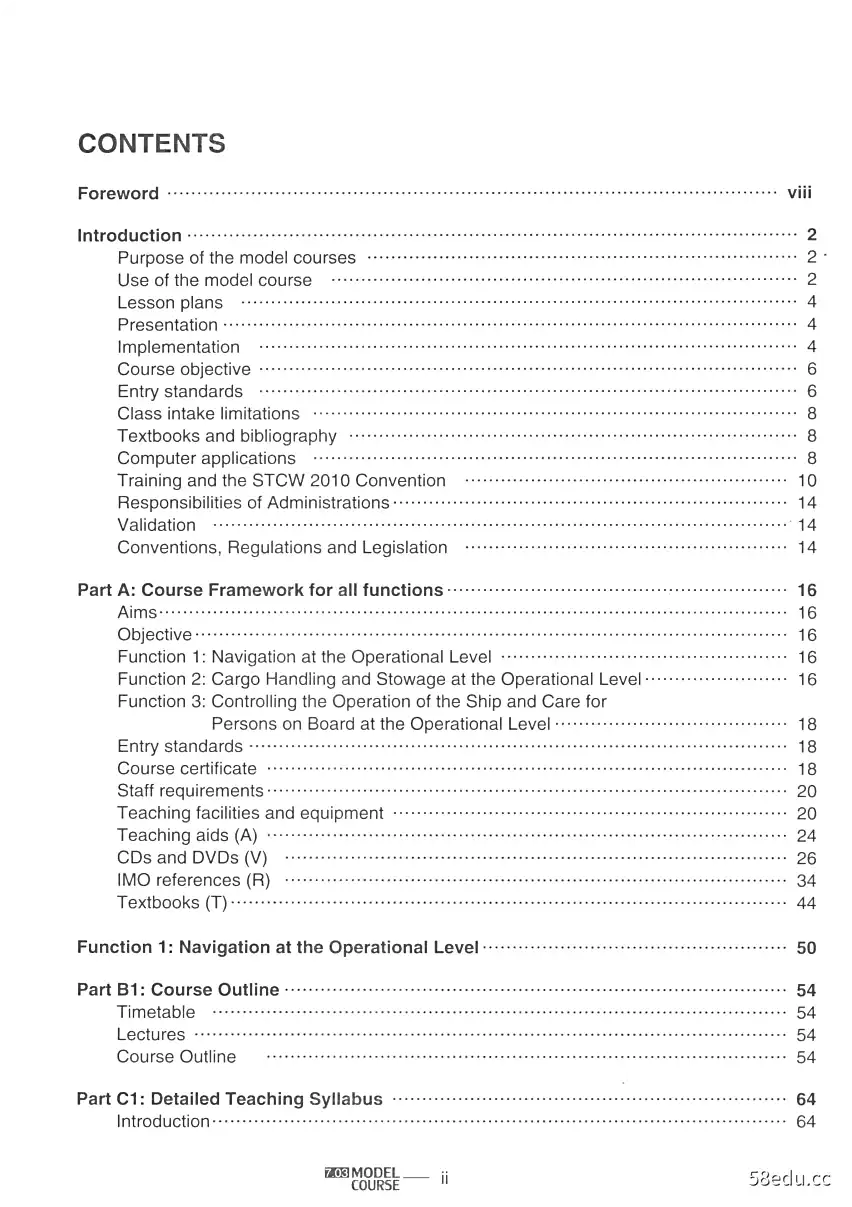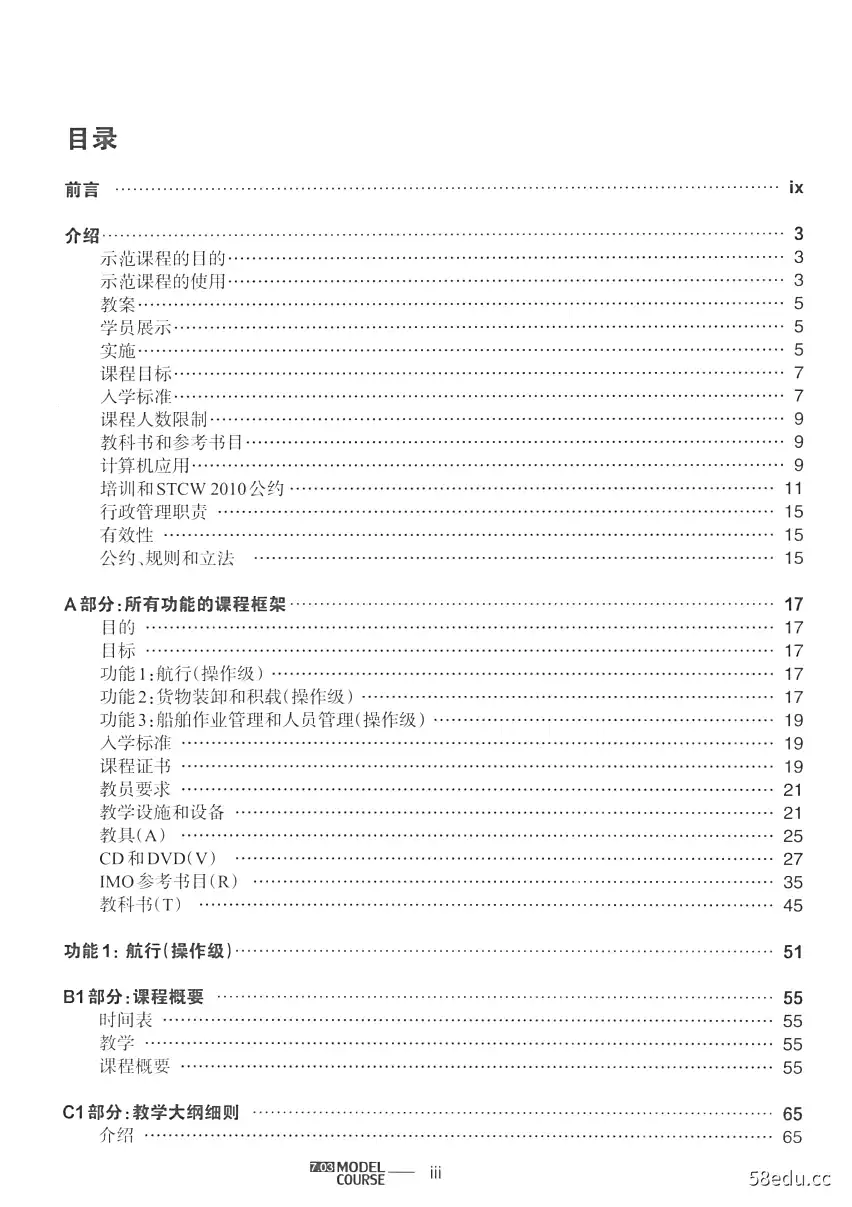《值班驾驶员 中英对照》国际海事组织著;中华人民共和国海事局译|(epub+azw3+mobi+pdf)电子书下载
图书名称:《值班驾驶员 中英对照》
- 【作 者】国际海事组织著;中华人民共和国海事局译
- 【丛书名】国际海事组织海员行为示范
- 【页 数】 531
- 【出版社】 大连:大连海事大学出版社 , 2016.12
- 【ISBN号】978-7-5632-3438-7
- 【价 格】85.00
- 【分 类】海船-驾驶员-技术培训-教材-汉、英
- 【参考文献】 国际海事组织著;中华人民共和国海事局译. 值班驾驶员 中英对照. 大连:大连海事大学出版社, 2016.12.
图书封面:
图书目录:


《值班驾驶员 中英对照》内容提要:
本书是国家出版基金项目“国际海事组织海员行为示范”之一,根据国际海事组织海员行为示范课程7.03翻译而成,全书为英汉对照,主要包含课程框架、课程概要和时间表、教学大纲细则、教员手册、评估等几个部分。介绍了值班驾驶员的相关内容。
《值班驾驶员 中英对照》内容试读
7.03 MODELCOURSE
值班驾驶员
Introduction
Purpose of the model courses
The purpose of the IMO model courses is to assist maritime training institutes and theirteaching staff in organizing and introducing new training courses,or in enhancing,updatingor supplementing existing training material where the quality and effectiveness of thetraining courses may thereby be improved.
It is not the intention of the model course programme to present instructors with a rigid"teaching package"which they are expected to "follow blindly".Nor is it the intention tosubstitute audio-visual or "programmed"material for the instructor's presence.As in alltraining endeavours,the knowledge,skills and dedication of the instructors are the keycomponents in the transfer of knowledge and skills to those being trained through IMOmodel course material.
Rather,this document should be used as a guide with the course duration given asindicative of the expected time required to cover the required outcomes.The parties maymodify this course to suit their respective training schemes.
For those following planned training schemes approved by the administration,it is intendedthat this training may form an integral part of the overall training plan and be complementaryto other studies.The training may be undertaken in progressive stages;for such candidates,it is not appropriate to specify the duration of the learning,provided achievement of thespecified learning outcomes is properly assessed and recorded.
The educational systems and the cultural backgrounds of trainees in maritime subjects varyconsiderably from country to country.For this reason the model course material has beendesigned to identify the basic entry requirements and trainee target group for each course inuniversally applicable terms,and to specify clearly the technical content and levels ofknowledge and skill necessary to meet the technical intent of IMO conventions and relatedrecommendations.
This is the second major revision to this model course.In order to keep the trainingprogramme up to date in future,it is essential that users provide feedback.New informationwill provide better training in safety at sea and protection of the marine environment.
Information,comments and suggestions should be sent to the Head of the STCW and
Human Element section at IMO,London.
Use of the model course
To use the model course the instructor should review the course plan and detailed syllabus,taking into account the information provided under the entry standards specified in thecourse framework.The actual level of knowledge and skills and the prior technical educationof the trainees should be kept in mind during this review,and any areas within the detailedsyllabus which may cause difficulties,because of differences between the actual traineeentry level and that assumed by the course designer,should be identified.To compensatefor such differences,the instructor is expected to delete from the course,or reduce theemphasis on,items dealing with knowledge or skills already attained by the trainees.Heshould also identify any academic knowledge,skills or technical training which they may nothave acquired.
70gM0DEL一2
COURSE
介绍
介绍
■示范课程的目的
MO示范课程的目的是协助海事培训机构及其教学人员组织和引入新的培训课程,提高、更
新或补充现有的培训教科书,以此改进培训课程的质量和培训效果。
本示范课程计划的意图并不是向教员呈交一个他们期望“盲目遵循”的“教学包”,其意图也不是用视听或“编排”的材料来代替教员的存在。在所有的培训过程中,知识、技能和教员的奉献
是向MO示范课程材料的受训者传授知识和技能的关键构成要素。
但是,本课程应该作为课时的参考,该课时即为达到预期效果所需的预计时间。各有关方可以修改本课程以满足各自的培训计划。
对于后续由主管机关批准的培训计划,本课程旨在形成总体培训计划的一个组成部分和其他学习的补充。这个培训可分阶段实施;对于有些受训申请者,若其指定学习成果可正确评价和合理记录,则无须指定学时长度
由于不同国家接受航海类培训的学员所处的教育体系和文化背景各不相同,所以示范课程
采用通用术语设计,可以适应各课程受训目标人群的基本要求,并明确提出了需要满足的MO
有关公约及相关决议案所必需的技术内容、知识和技能的水平。
本书是本示范课程的第二次主要修订。为使今后的培训内容保持更新,使用者应提供反馈意见。新的信息将为海上航行安全及海洋环境保护提供更好的培训。相关信息、评论及建议应
送达设在伦敦的STCW总部及MO人为因素科。
■示范课程的使用
为使用示范课程,教员应当审视课程计划和教学大纲细则,考虑课程框架中规定的入门标准所提供的信息。在审视过程中,应当牢记学员知识和技能的实际水准以及从前的技术教育,并应当识别出在教学大纲细则范围内由于学员实际入门水准与课程设计者假定的水准之间的差异,可能引起困难的任何部分。为弥补这些差异,希望教员将涉及学员已经掌握的任何学术知识、技能和技术训练。
Z08M0D县一3
COURSE
值班驾驶员
By analysing the detailed syllabus and the academic knowledge required to allow training inthe technical area to proceed,the instructor can design an appropriate pre-entry course or,alternatively,insert the elements of academic knowledge required to support the technicaltraining elements concerned at appropriate points within the technical course.
Adjustment of the course objective,scope and content may also be necessary if in yourmaritime industry the trainees completing the course are to undertake duties which differfrom the course objectives specified in the model course.
Within the course plan the course designers have indicated their assessment of the timethat should be allotted to each area of learning.However,it must be appreciated that theseallocations are arbitrary and assume that the trainees have fully met all entry requirementsof the course.The instructor should therefore review these assessments carefully and mayneed to re-allocate the time required to achieve each specific learning objective or trainingoutcome
Lesson plans
Having adjusted the course content to suit the trainee intake and any revision of the courseobjectives,the instructor should draw up lesson plans based on the detailed syllabus.Thedetailed syllabus contains specific references to the textbooks or teaching materialproposed to be used in the course.Where no adjustment is found necessary in the learningobjectives of the detailed syllabus,the lesson plans may simply consist of the detailedsyllabus with keywords or other reminders added to assist the instructor in making hispresentation of the material.
■
Presentation
The presentation of concepts and methodologies must be repeated in various ways until theinstructor is satisfied,by testing and evaluating the trainee's performance and achievements.that the trainee has attained each specific learning objective or training outcome.Thesyllabus is laid out in learning objective format and each objective specifies a requiredperformance or what the trainee must be able to do as the learning or training outcome.
Taken as a whole,these objectives aim to meet the knowledge,understanding andproficiency specified in the appropriate tables of the STCW Code.
■Implementation
For the course to run smoothly and to be effective,considerable attention must be paid tothe availability and use of:
o properly qualified instructors
●support staff
●rooms and other spaces
●equipment
●suggested references,textbooks,technical papers,bibliography
●other reference material
Z03 MODEL
COURSE
介绍
通过分析教学大纲细则以及技术领域培训所需的学术知识,教员可以设计出适当的预料课程,或者在技术课程中的适当处加入技术课程需要的学术知识
如果完成该课程的学员在其所处的航海事业中要从事有别于本示范课程规定的课程目标的职责,则可能有必要调整课程的目标、范围和内容。
在课程计划中,课程设计者已经表明了其估计的、应分配给每一个学习部分的时间,但是,必须清楚的是,这些分配尚不够严谨,且假设这些学员完全符合本课程的人门要求。因此,教员应当谨慎审视这些估计,并且需要重新调整教学时间安排,以实现各类教学目标和培训的成果。
◆
教案
在为适应招收的学员以及课程目标的修正而调整课程内容之后,教员应当基于大纲细则拟定教案。大纲细则中有教科书具体的参考书目以及计划用于课程的教学资料。教案可以包括添加了关键词或提示语的大纲细则,以帮助教员授课,在这种情况下,就没有必要调整大纲细则的培训目标
●
学员展示
与概念和方法相关的内容必须以不同的方式重复讲授,测试和评价学员的技能和成绩,直到教员认为学员已经符合培训要求,并达到特定学习目标且取得特定的培训效果。教学大纲以学习目标的格式呈列,而且每个目标规定了对应的技能要求,或者学习、培训效果主要审查学员应
知、应会内容方面的能力。从整体上看,这些目标旨在满足STCW规则相应表格规定的知
识、理解和熟练
◆
实施
为使课程顺利进行和卓有成效,必须充分注意下列资源的获得和使用:
·完全合格的教员:。辅助人员:
。教室和其他场所:
●设备:
。推荐的参考资料、教科书、技术论文;
●其他参考资料
703 MODEL
5
COURSE
值班驾驶员
Thorough preparation is the key to successful implementation of the course.IMO hasproduced a booklet entitled 'Guidance on the implementation of IMO model courses',whichdeals with this aspect in greater detail.
In certain cases,the requirements for some or all of the training in a subject are covered byanother IMO model course.In these cases,the specific part of the STCW Code whichapplies is given and the user is referred to the other model course.
Course objective
This model course comprises three functions at the operational level.On successfulcompletion of the training and assessment trainees should be competent to carry out safelythe watchkeeping duties of an officer in charge of a navigational watch,both at sea and inport.In particular,they will be fully conversant with the basic principles to be observed inkeeping a navigational watch as per STCW regulation VIll/2 and STCW Code,chapter VIll.
The teaching schemes should be carefully scrutinized to ensure that all of the tabulatedtraining outcomes are covered,that repetition is avoided and that essential underpinningknowledge at any stage has already been covered.A certain amount of duplication underdifferent subjects will probably occur,provided it is not excessive,the different approachescan provide useful reinforcement of work already learned.Care should be taken to see thatitems not included in the syllabus or treatment beyond the depth indicated by the objectiveshave not been introduced except where necessary to meet additional requirements of the
Administration.The teaching scheme should be adjusted to take account of those mattersand the timing of any modular courses (such as training in firefighting,medical care)that areto be included.
Entry standards
The minimum educational standards for entry to the profession may be prescribed by the
Administration.In preparing this course it has been assumed that entrants will havesuccessfully completed a minimum period of full-time general education of about 10 to 12years.They should have reached a standard in mathematics and physical science whichwould enable them to undertake the learning as set out in the syllabuses for those subjects.
Where entrants have not reached the required standard in mathematics or physical scienceit will be necessary to provide a preparatory course or courses to bring them to the desiredlevel before starting the professional studies.
Conversely,topics which have been adequately covered during their general education canbe omitted and the allotted time reduced accordingly.
No previous maritime training is assumed,but those entering the course should be followingan approved programme of shipboard training.
703 MODEL
6
COURSE
···试读结束···
作者:毕平
链接:https://www.58edu.cc/article/1593814152885854210.html
文章版权归作者所有,58edu信息发布平台,仅提供信息存储空间服务,接受投稿是出于传递更多信息、供广大网友交流学习之目的。如有侵权。联系站长删除。